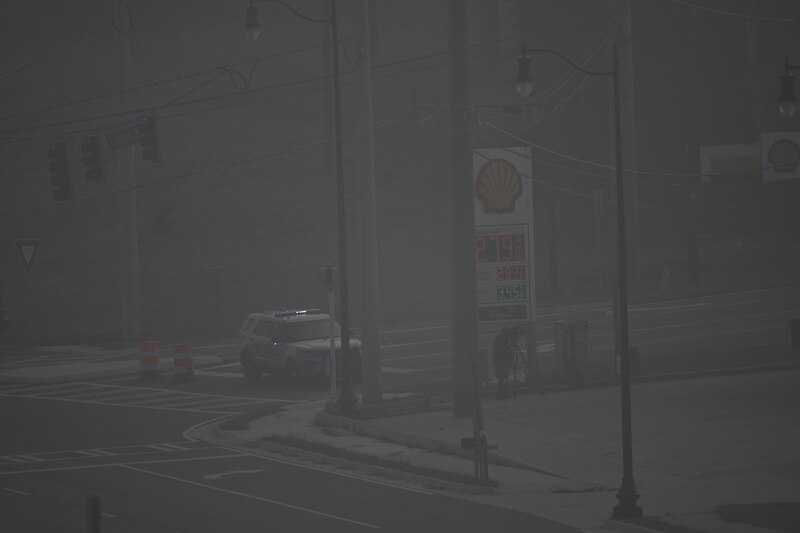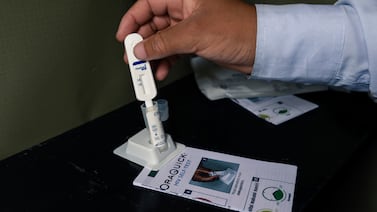Public health, explained: Sign up to receive Healthbeat’s free Atlanta newsletter here.
As a plume of smoke from a fire at a Conyers chemical plant hangs over metro Atlanta, so do questions about what exactly is burning and the extent of any public health risk.
The fire started Sunday at the BioLab factory, which manufactures chemicals used in pools and spas. The fire was still smoldering Tuesday, with smoke expected to linger all week.
The blaze prompted evacuation orders for about 17,000 people near the plant, shelter-in-place orders for thousands more and the closing of Interstate 20. Rockdale County Public Schools were closed for fall break, but Newton County Schools closed Monday and Tuesday. Other districts canceled outdoor after-school activities.
Public health officials insist the air, fouled by burning “chlorines, chloramine and chlorine compounds,” is safe to breathe but have released few details.
People in Atlanta may experience watery eyes and scratchy throats that should subside as the air clears, said Carmen Marsit, a professor of environmental health at Emory University. Those who live closer to the plant may have a cough or other respiratory symptoms, which could be worse for those with asthma or chronic obstructive pulmonary disease.
People with severe symptoms or for whom the symptoms don’t clear should contact their medical provider, he said.
The Environmental Protection Agency has established testing sites near the plant to check the air for chemicals including hydrogen chloride, chlorine, and hydrogen sulfide. The agency’s website referred to a strong chlorine smell but said it is not harmful.
“To our knowledge, the chemicals released from this fire are the chlorines, chloramine and chlorine compounds,” Dr. Lynn Paxton, interim health director for the Gwinnett, Newton, and Rockdale Health District, said at a Tuesday news conference. “The levels of the chemicals reported to date are below the levels that have been previously recognized to cause symptoms in most people.”
The latest data from the EPA suggests that 0.5 parts per million is the level at which action may need to be taken. Chlorine levels remained mostly below that level between Monday night and Tuesday morning, although they did top the action level at two monitoring stations in that timeframe.
“No significant toxicity has been identified in the smoke,” the Georgia Department of Public Health said in a press release Monday. It provided no updates on Tuesday.

Air pollution could linger till weekend
Still, Rockdale County offices remained closed Tuesday and county officials advised residents to stay indoors if the smoke plume is nearby or if they have respiratory conditions. Others recommended closing windows and doors and ensuring that air conditioners are using recirculated air.
N95 masks are unlikely to help because chlorine compounds are too small to be filtered, Paxton said.
The pollution, which may get worse at night, could linger through the end of the week, Rockdale County Chairman Oz Nesbitt said at Tuesday’s news conference.
“You will continue to see that plume, but don’t think that the situation is not uncontrolled or not being mitigated, it is being mitigated,” Nesbitt said.
Rockdale County Fire Chief Marian McDonald said teams were working to move the chemicals away from the “hot zone” at the burned factory.
The city of Atlanta, about 30 miles west, said in a press release the Fire Rescue Department had been monitoring air quality with handheld monitors and drones.
“All results have come back within acceptable levels,” the release said, with testing continuing Tuesday.
Some health experts say they need more information on what chemicals have been burning at the plant to assess the true health risk. There are many kinds of chlorine compounds.
A BioLab representative declined to answer emailed questions about which chemical caught on fire or how the fire started, referring instead to online press releases, which did not contain that information.
Without knowing more details, it’s hard to know what the short- and long-term health impacts might be, said Roby Greenwald, associate professor at the Georgia State University School of Public Health.
“We don’t actually know what’s in the fire,” he said. “The exact effects … really depend on what’s in that plume.”
How the particulates are measured matters, too, he said.
One standard air quality measure, particulate matter 2.5 or PM2.5, measures fine inhalable particles in the air but not what those particles are made of. If the particles are toxic, that changes the equation, Greenwald said.
“It’s not like [public health officials are] incorrect to say that this is a level that complies with standards. But there were periods of an hour or so within the day when you saw big differences,” said Greenwald, who was monitoring air quality on PurpleAir, a map that provides real-time data drawn from citizen scientists’ sensors around the country. Those might show up in a short measurement window, but not a 24-hour average.
Although the fire was out by Tuesday, it was still smoldering, and smoldering materials can be equally or even more toxic than burning chemicals.
“There’s not a lot of transparency right now,” Greenwald said.
Marsit expressed less concern.
“These sort of short-term exposures that kind of come through and then go away are a bit less concerning …. compared to kind of a constant exposure that we would have everyday with traffic,” he said.
Rockdale air pollution was already high
Anderson and Greenwald said people of color and vulnerable populations bear an unequal burden on their health by living near the factory.
Even before the fire, Rockdale County had below average health outcomes and higher-than average air pollution rates, according to County Health Rankings from the University of Wisconsin Population Health Institute.
Of Rockdale’s 95,000 residents, about 61% are Black, and 11% Hispanic. About 18% of children live in poverty.
“There are very frequently health equity concerns in air pollution events like this, especially if it’s something from a human-made source,” Greenwald said. “Lots of times we locate the human-made sources in places where property values are low,” creating increased risk nearby.
BioLab chemical inventory undisclosed
BioLab has a history of fires – and secrecy – at facilities in Georgia and Louisiana.
Patrick Anderson, a staff attorney at the Southern Environmental Law Center, said BioLab may never disclose what chemicals are burning in Conyers. An EPA inspection report on a September 2020 fire at the plant does not include the facility’s chemical inventory, and a cover note states the company asked the EPA not to publish certain “confidential business information.”
The U.S. Chemical Safety and Hazard Investigation Board has investigated past incidents at BioLab facilities. That board investigates serious chemical accidents in much the same way the National Transportation Safety Board investigates train and plane crashes.
After a fire at a Louisiana BioLab plant in 2020, the board recommended the EPA put “self-reactive chemicals made at BioLab on a list of highly dangerous chemicals requiring additional safety plans. However, that did not happen, Anderson said.
“Fires and accidents happen …. When it does happen multiple times, it’s always a case of something is wrong,” Anderson said. “It just can’t be the case that you can operate a facility that every couple of years has an event that results in thousands of people sheltering in place or being evacuated.”
The Environmental Protection Division of the Georgia Department of Natural Resources also has jurisdiction over the plant. Officials did not immediately respond to a request for more information about past steps to ensure safety at BioLab facilities or what the consequences of the most recent fire might be.
Rebecca Grapevine is a reporter covering public health in Atlanta for Healthbeat. Contact Rebecca at rgrapevine@healthbeat.org.







